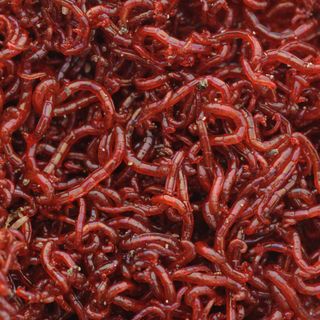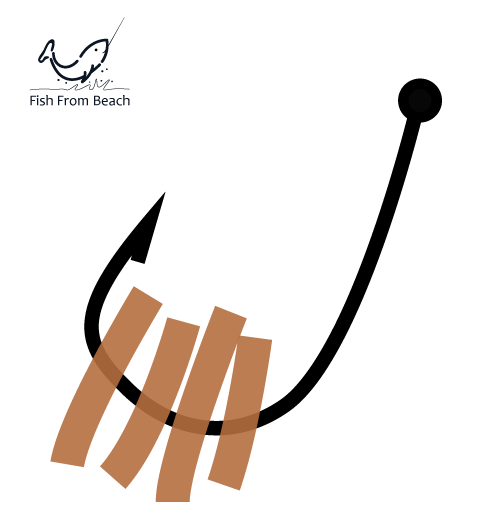Surf fishing with worms is very popular. You can go to any beach in the world where anglers are surf fishing and ask them if they carry live worms with them.
I bet many of them will answer : YES, I do have worms !
Why ? simply because surf fishing with worms is very productive, very rewarding and also cost-effective. In fact, you may be missing a lot of catches and losing a lot of money if you don’t use worms as bait.
It is therefore essential for any fisherman to learn how to surf fish with worms, at least as a backup solution when other baits and lures do not produce the expected results.
In this guide, we will explain why worms are great for surf fishing and how to effectively use these small wiggling creatures to catch fish from shore.
Why worms are great for surf fishing ?
Worms are great for surf fishing for many reasons.
First of all, they are easy to find, cost-effective, and very simple to use on a hook, making it the best option for beginners and children.
You can simply dig in your garden or backyard for nightcrawlers, pierce them in your hook, throw the line in the surf and you’re ready for a bite.
The second reason, sea fish do like worms !
Although there is no clear scientific explanation for this, as worms do not live in the sea and would never be met by fish if they were not introduced by humans, it is still obvious that worms are one of the saltwater fish’s favorite meals.
The only rational explanation I have for this is that worms are wiggly and smell good in the water. This provokes fish and draw their attention when looking for something to eat.
The third reason why worms are good baits for surf fishing is that they are less messy than the other natural baits.
The use of baitfish for surf fishing is very rewarding, but you should expect to have your hands, clothes and tackle full of blood, guts, and dirt. which is not very fun.
Worms can be messy too, but in general, they produce fewer liquids and dirt and require less maintenance and cleaning.
Read this article for more about the pros and cons of natural baits.
What worm to use for surf fishing ?
In addition to the fact that worms are perfect for shore fishing, they also come in many colors, shapes, and sizes, which gives us many options when choosing the bait to throw in the waves.
Here are the most popular options :
Nightcrawlers

The most common worms for surf fishing are nightcrawlers. They are easy to acquire, simple to hook and above all, work very well for surf fishing.
Nightcrawlers burrow down the soil and can be found 6 feet deep under the ground. They are one of the largest species of worms, as they can grow up to 14 inches and weigh up to 0.14 oz. This forces many fishermen to cut the nightcrawlers into several segments before threading them on hooks.
Another great thing about nightcrawlers is that you can find them right in your backyard, so be sure to dig for some before your next surfcasting trip.
Bloodworms

The same as nightcrawlers, bloodworms are also a large species of worms that can grow up to 12 inches.
Blood worms are good for surf fishing because their transparent skin makes it easy to see their blood and thus attract hungry fish.
However, you should always be careful when handling live blood worms because they have the ability to bite humans when they feel the danger. And guess what ? although they are small creatures, they hurt a lot and can make you bleed.
Waxworms

Waxworms are also very popular when it comes to beach fishing.
Their fat content and meaty appearance, as well as their lively action on the hook, give much appeal and attractiveness.
Because of their small size, many fishermen run multiple waxworms on the hook, but in general, a single waxworm will do very well too.
Waxworms can also be used with lures because they give artificial baits a natural look and thus maximize hookups.
Lugworms

Lugworms or sandworms are large species of worms living in the intertidal zone of sheltered beaches, bays, and harbors.
They are very attractive to fish because they are juicy, smelly and very active on hooks.
What makes lugworms special for surf fishing is the possibility to find them under the sand while you are on the beach.
This is an effective tool that you can find for free while in the office. Great no ?! 😉
So the next time you run out of bait, consider digging for some lugworms underfoot and continue fishing.
Mealworms

Mealworms are also an excellent alternative for surf fishing and fish are strongly attracted to them, especially during the last months of summer.
Personally, mealworms are my favorite bait for surf fishing with worms. Why ? for the simple reason that they are smaller than nightcrawlers, and thus allow for better presentation and stability when stuck to a hook.
Another reason why mealworms are good for surf fishing is their rigid skeleton wish makes hooking them easy and more durable.
Also, mealworms release good scent when dropped in the water, helping to attract more hungry fish.
What worm size is ideal ?
Now that we have covered the most common worm species used for surf fishing, it is important to know which worm size is ideal ?
Well, this is a tough question that can not be answered easily. Why ? Because no worm size is perfect, and whatever the size you choose, there will always be constraints and challenges to overcome.
The use of large worms is ideal for targeting large predators and filtering the small fish out. But presenting a too large worm on a hook can be counterproductive because the bait can easily slip when you cast the line. In addition, the fish can tug a big worm without getting caught.
On the other hand, small worms are effective and more stable on hooks, and they are a good option if you are not targeting a specific fish size. But if you want to catch the big predators only, then using small worms is not the option to go, as they can not prevent small fish from hitting your bait, and thus, you can finish the day with many species that you are not interested in.
Personally, I’m always on the smaller side because I hate to lose so many worms without catching fish.
A small worm is difficult to steal and fit best on a hook, which maximizes the catch per bite ratio.
Ok, I understand. But what size exactly ?
It depends on the size of my hook, which also depends on the size of the fish I want to catch.
In other words, I always use worms big enough to fully cover the hook, but small enough so I leave only a small part of the worm unhooked.
If I can not find a worm this size in my box, I would pick a larger worm, cut it into smaller pieces and thread the hook with a single piece.
However, cutting worms into pieces might reduce their activity and movement on the hook, which seems less natural and more suspicious to fish. In addition, cutting a worm releases the fluids in its body, which makes it less attractive and appetizing to fish. This is why I prefer mealworms because they are often small enough to be hooked well as whole.
Best way to hook a Worm for surf fishing
There are many ways to hook a worm for surf fishing, and each method has its advantages and disadvantages.
The traditional method

The most popular method and most used way to hook a worm is what we call the traditional method.
This method consists of threading the hook back and forth several times with a single worm until it gets well stuck to the hook.
This is my favorite method of hooking worms because it’s simple, effective at keeping the bait stable on the hook, and most importantly, it’s the most attractive way to present worms to fish.
Piercing the worm this way allows it to keep a slight movement on the hook, and thus look more natural, more appealing and more attractive to fish.
However, this method is best used with small worms. Why ? because hooking a large worm this way makes it so easy to be stolen without catching fish, which will make you lose a lot of worms.
The end to end method

The other most used method of hooking worms is the end to end method.
Pick a worm, pierce it just under the head and start sliding it up through the curve of the hook. Keep pushing the worm until the head reaches the eye of the hook or even the line.
When the hook gets entirely inside the body of the worm, it’s a good idea to pierce the other end of the worm so it does not slide back when you cast the line.
The biggest advantage of this method is that it allows the angler to catch much fish without changing the worm.
Because the worm is completely stuck to the hook, the fish can not pull it easily, so it will remain intact and stuck on the hook for a long period of time.
However, a worm presented this way seems less attractive and less appealing to fish because it can not easily move and wiggle. That’s why I recommend leaving a small part of the worm unhooked so that it can hang freely and have a more natural look.
The free worm method

Compared to the previous methods, this is the most natural way to present a worm on a hook.
By piercing a worm only once in the center of the body, it can freely move and wiggle when thrown into the surf, and thus look like natural food to most fish.
Moreover, it is obviously the easiest way to hook a worm. A simple move and you are ready to launch the line.
But, like the other methods, this one has some disadvantages too.
First, a warm hooked this way is so easy to slip out of the hook when you cast the line. Second, fish can easily steal the worm without getting caught.
In addition, as the hook remains fully exposed, presenting the worm this way is a bad choice if you are dealing with picky and suspicious fish.
Personally, I do not like this method because I have tried it before and even though It helped me to catch a lot of fish, especially big fish, I lost so many worms and spent a lot of time baiting my hooks.
That’s why I only recommend this method when you are on a super hot spot, where predators are not too picky and are big enough to eat the whole worm without much hesitation.
Multiple worms method

A less common way to hook a worm is to cut it into several small pieces and hang all the pieces in the middle of the hook so that they stay stacked closely together.
This method provides good stability and makes the bait hold very well on the hook. Also, it’s hard for fish to steal the worms when they are presented this way.
As we said before, you can cut long worms into multiple pieces and hook each part separately, but you can also use multiple small worms like waxworms.
Hooking a whole worm is always a better choice because of the natural look.
Other tips for surf fishing with worms
- If you constate that you are losing a lot of worms without catching fish, consider reducing the size of the worms or opt for the end-to-end method.
- When piercing a worm, try to keep as much as possible fluids in its body to maximize its appeal when dropped in the water.
- The best rig for surf fishing with worms is the fish finder rig because of its ability to keep the bait at the bottom and allow it to move freely and naturally with the current, attracting hungry fish.
- Keep your worms cool and away from heat. Worms are most attractive to fish when they are cool and fresh. Also, cool worms are easier to hook.
- Make sure to reel in your line every 15 or 20 minutes to make sure your hook is still baited. worms can easily get stolen by fish without getting hooked, thus you can lose a lot of time waiting for a bite while your hook is already empty.
- You should also retrieve the line more often so you can check the state of the worm on your hook. If the worm does not move or seems pale, you must change it systematically because worms are only effective if they are alive and fresh.
Note (*): If you make a purchase through links from this website, we may get a small share of the sale from Amazon or other similar affiliate programs.
Surf Fishing Survey
Help us provide you with better content by answering simple questions about your surf fishing experience and knowledge.
We will put the collected responses together and turn them into valuable information that will help you catch more fish from shore 😉
Note: No personal information will be collected with your answer.


